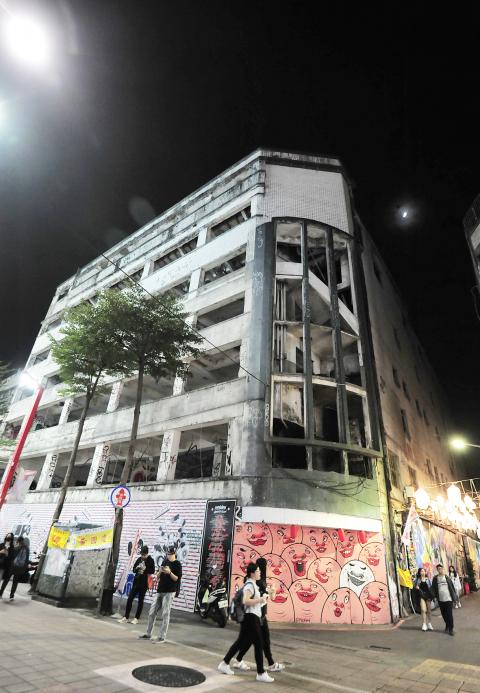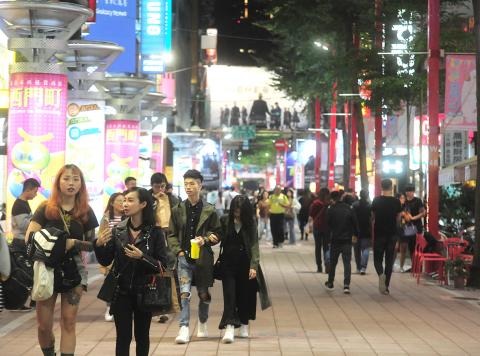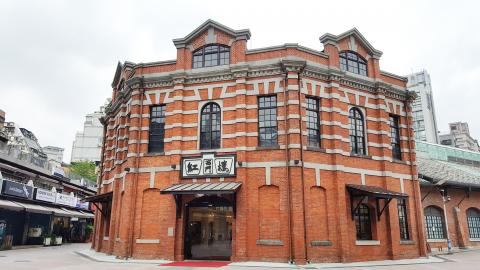Taipei Movie Theater opened its doors for the first time during the 1950s and was the number one choice for today’s sexagenarians and septuagenarians to watch movies in their youth. Wu Yi-shui, who was the local borough warden for 12 terms, says: “Back then the place was full of moviegoers. A small army of ticket scalpers plied their trade up and down the streets.” At first, Taipei Movie Theater mainly showed Japanese films and was as popular as Taipei’s First Theater. It was only later that Chou Chen Yu-shu, who would become known as the “Father of the Taiwanese film industry,” opened a series of three movie theaters known as the three “shengs.”
The original iteration of Taipei Movie Theater was constructed and operated by the Chou family, who made their wealth within the construction industry: why they decided to open a movie theater has been lost to the annals of history. Based upon information gleaned from the construction permit, it would have cost no more than NT$120,000 to build. The property rights to the building were inherited by later generations of the Chou family, and there are currently more than 10 people in possession of property or land rights: Some hold an interest in the property but hold no land rights; others possess land rights without a stake in the building. Additionally, some family members emigrated overseas or could not be contacted. The complexity of the ownership structure led to a situation in which the theater has been out of operation for nearly 30 years.
Wu says that despite sharing the same surname, Taipei Movie Theater, built by the Chou family, and LUX Cinema, also in Taipei’s Ximending area and constructed by Chou Chen Yu-shu, were most likely unrelated. Wu says that Chou Chen Yu-shu originally started out selling noodles, but after making his fortune in real estate, opened a series of movie theaters, including the three “shengs” — LUX Cinema, Hsinsheng Theater and Kuosheng Theater. According to Wu, the advent of the video cassette, cable television and, in more recent times, smart phones, have all had an impact, and today the number of moviegoers coming to Ximending pales in comparison with years past.

Photo: Wang Yi-sung, Liberty Times
照片:自由時報記者王藝菘
Taipei Movie Theater had a good run: in addition to being the first movie theater to open on what is now known as Ximending’s “Cinema Street,” it also boasted the largest movie theater auditorium and could seat 1,700 moviegoers. Later, when showing the Western movie The Winners (aka My Way), it established a new box office record for Taiwan, breaking the NT$10 million mark. At the time, the majority of tickets were priced around NT$10-NT$30, compared to today’s ticket prices of NT300-NT$400 per movie.
At the end of the 1970s, Taipei Movie Theater screened the Taiwanese-made 3D martial arts film 1,000 Miles to Recover a Knife and gradually became known as the leading theater for screening Taiwanese movies. As the movie industry fell into decline, the theater was unable to avoid the knock-on effect and one year after screening Tsui Hark’s martial arts film The Swordsman, Taipei Movie Theater closed its doors in 1991. The theater was subsequently converted into a Japanese pachinko slot machine and arcade game parlor, but after Taipei City Government initiated a campaign to root out gambling arcades, the building fell into disuse.
(Translated by Edward Jones, Taipei Times)

Photo: Wang Yi-sung, Liberty Times
照片:自由時報記者王藝菘
一九五十年代開幕的「台北戲院」,是六、七十歲老台北人看電影的首選地點。在當地擔任十二屆里長的吳益水說:「當時看電影的人好多啊。路上多的是賣黃牛票的人。」最初該戲院是播放日片為主,與當時的「第一劇場」齊名,之後才有「電影之父」周陳玉樹的三「聲」系列電影院。
「台北戲院」最早是周氏家族自建並經營;據悉,周氏家族原本是建築業起家,興建戲院的原因已經不可考,根據建照資訊,當時標註工程費用僅十二萬元。而後隨著產權繼承,目前持有建物與土地的產權超過十人,部分是有建物、沒土地,部分有土地、沒建物產權,加上部分家族成員已移居海外、聯絡不上,因此停業近三十年。
吳益水說,興建「台北戲院」的周氏家族與興建樂聲戲院的西門町電影王國之父周陳玉樹應該是沒有關聯,後者最早是賣麵,之後因土地致富才開設新生、樂聲、國聲等三「聲」戲院。但他感嘆說,受到錄影帶、第四台,乃至於現在的智慧型手機發達影響,現在西門町看電影的人潮已經不復從前。

Photo: Yang Hsin-hui, Liberty Times
照片:自由時報記者楊心慧攝
「台北戲院」早年在台灣電影史上留下不少輝煌紀錄,除了是西門町「電影街」首家開幕電影院,更擁有當時最大放映廳。根據描述,可容納超過一千七百人,後因為播放洋片「奪標」,締造放映台灣電影史上首部破千萬票房的戲院,當時的電影票頂多幾十元,不像現在三、四百元起跳。
一九七十年代後期,曾放映台灣自製的3D立體武俠電影「千刀萬里追」,也逐步轉型為放映國片的龍頭戲院;無奈隨著電影產業沒落,放映完徐克武俠片「笑傲江湖」後一年就宣告停業,之後轉為柏青哥與電玩場,因市府掃蕩賭博電玩,自此荒廢。
(自由時報記者徐義平)
讀後練習FOLLOW UP
The Red House Theater
The Red House Theater (紅樓劇場) in Taipei’s Ximending area is a historic theater dating back to 1908 and the Japanese colonial era. Designed by Japanese architect Kondo Juro, it was originally a market building, named the Octagon, but the second floor was subsequently converted into a traditional theater which then began screening films in 1945.
It was the place to be seen during the 1950s and a popular haunt for youngsters back in the day. However, the theater gradually fell into disuse during the 1970s as newer, more modern movie theaters opened up nearby.
The theater was listed as a Class Three Historical Site in 1997 and re-opened in 2002 as an arts venue following a lengthy period of restoration. Today the Red House continues to be an important landmark in the bustling Ximending area.
(Edward Jones, Taipei Times)

In an effort to fight phone scams, British mobile phone company O2 has introduced Daisy, an AI designed to engage phone con artists in time-wasting conversations. Daisy is portrayed as a kindly British granny, exploiting scammers’ tendency to target the elderly. Her voice, based on a real grandmother’s for authenticity, adds to her credibility in the role. “O2” has distributed several dedicated phone numbers online to direct scammers to Daisy instead of actual customers. When Daisy receives a call, she translates the scammers’ spoken words into text and then responds to them accordingly through a text-to-speech system. Remarkably, Daisy

Bilingual Story is a fictionalized account. 雙語故事部分內容純屬虛構。 Emma had reviewed 41 resumes that morning. While the ATS screened out 288 unqualified, she screened for AI slop. She could spot it a mile away. She muttered AI buzzwords like curses under her breath. “Team player.” “Results-driven.” “Stakeholder alignment.” “Leveraging core competencies.” Each resume reeked of AI modeling: a cemetery of cliches, tombstones of personality. AI wasn’t just changing hiring. It was draining the humanity from it. Then she found it: a plain PDF cover letter. No template. No design flourishes. The first line read: “I once tried to automate my

Every May 1, Hawaii comes alive with Lei Day, a festival celebrating the rich culture and spirit of the islands. Initiated in 1927 by the poet Don Blanding, Lei Day began as a tribute to the Hawaiian custom of making and wearing leis. The idea was quickly adopted and officially recognized as a holiday in 1929, and leis have since become a symbol of local pride and cultural preservation. In Hawaiian culture, leis are more than decorative garlands made from flowers, shells or feathers. For Hawaiians, giving a lei is as natural as saying “aloha.” It shows love and

1. 他走出門,左右看一下,就過了馬路。 ˇ He walked outside, looked left and right, and crossed the road. χ He walked outside and looked left and right, crossed the road. 註︰並列連接詞 and 在這句中連接三個述語。一般的結構是 x, y, and z。x and y and z 是加強語氣的結構,x and y, z 則不可以。 2. 他們知道自己的弱點以及如何趕上其他競爭者。 ˇ They saw where their weak points lay and how they could catch up with the other competitors. χ They saw where their weak points lay and how to catch up with the other competitors. 註:and 一般連接同等成分,結構相等的單詞、片語或子句。誤句中 and 的前面是子句,後面是不定詞片語,不能用 and 連接,必須把不定詞片語改為子句,and 前後的結構才相等。 3. 她坐上計程車,直接到機場。 ˇ She took a cab, which took her straight to the airport. ˇ She took a cab and it took her straight